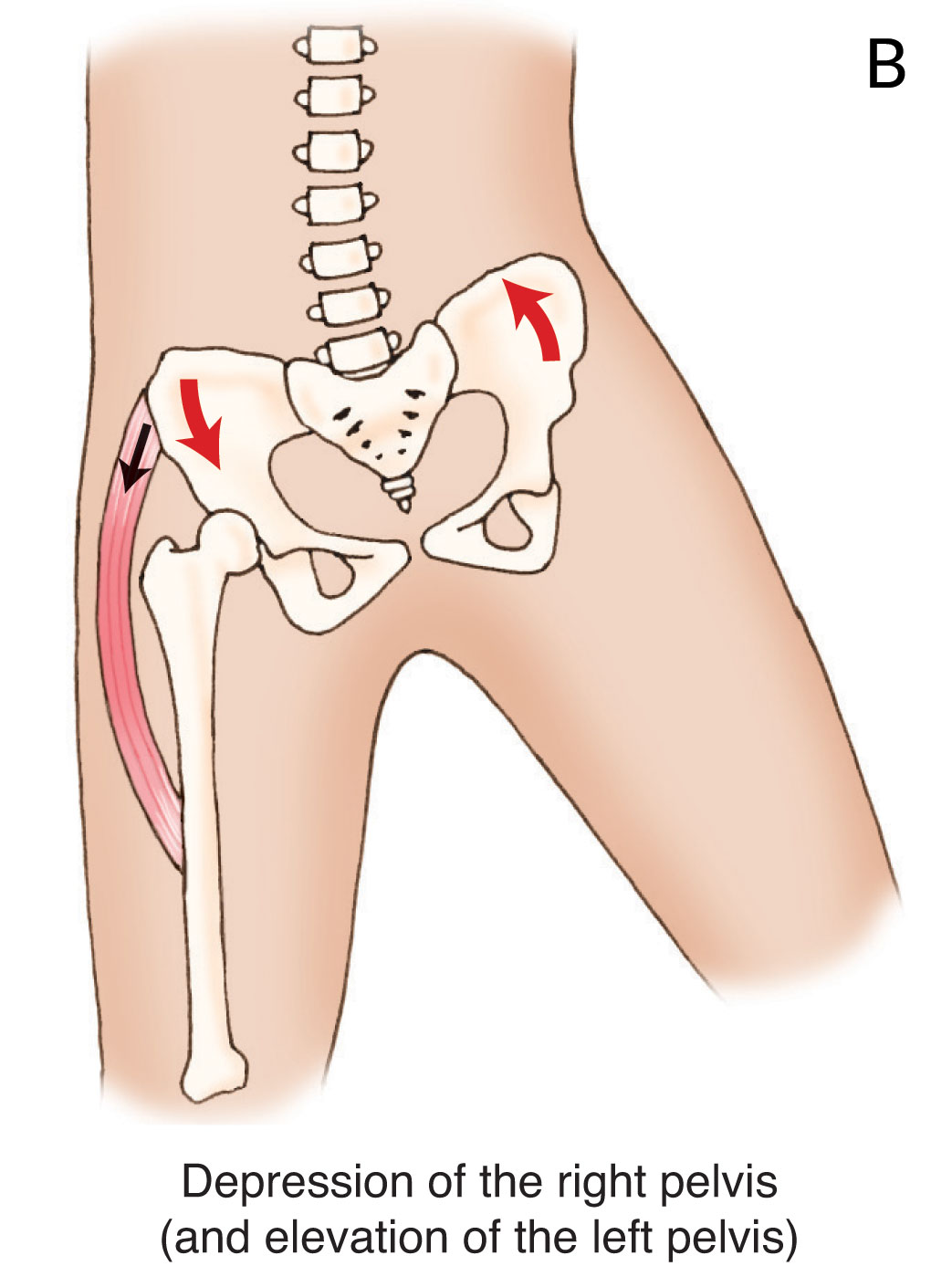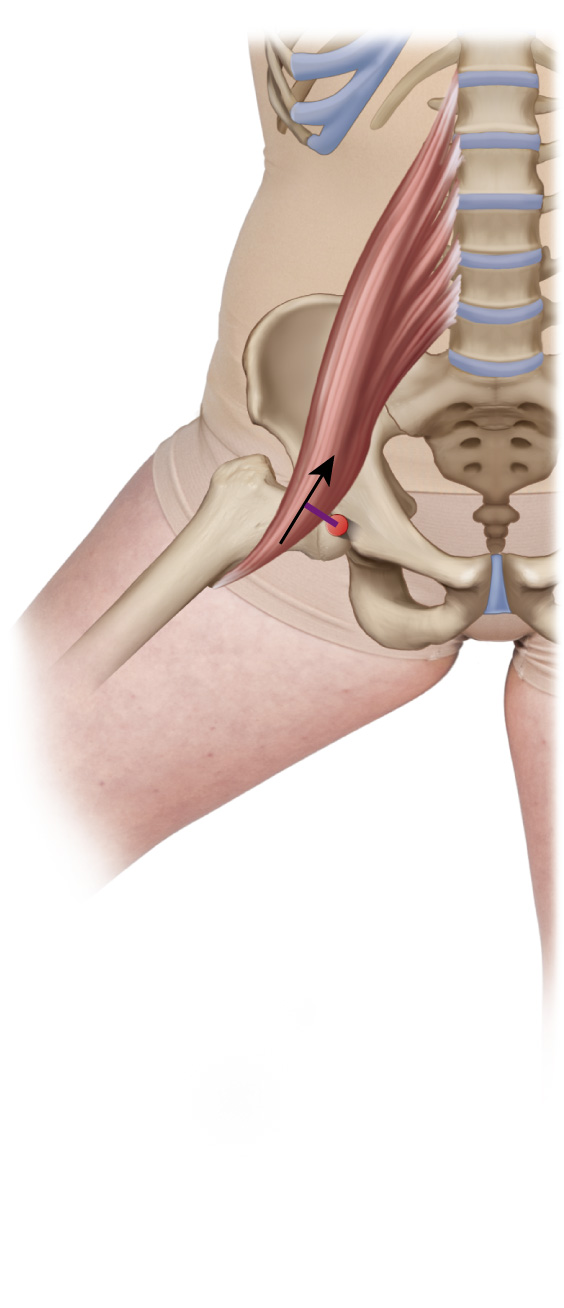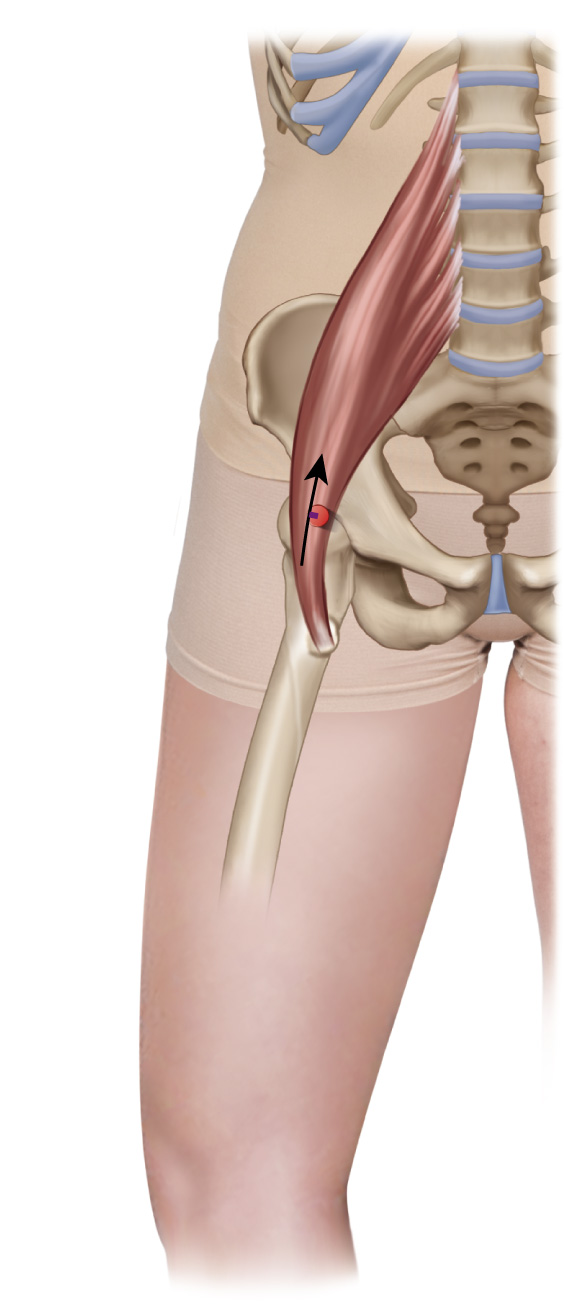Note: This is the fourth blog post article in a series of 11 articles on Psoas Major Function. See below for the other articles in this series on psoas major function.
Within the frontal plane at the hip joint, if the open-chain standard action is abduction of the thigh at the hip joint, the closed-chain reverse action is depression of the pelvis at the hip joint (Figure 8) (14, 19).


Figure 8. Frontal plane motion at the hip joint. A, Open-chain abduction of the thigh at the hip joint. B, Closed-chain depression of the same-side pelvis at the hip joint. Reproduced with kind permission from Muscolino, J. E., Kinesiology: The Skeletal System and Muscle Function (3rd ed.). 2017. Elsevier.
Frontal Plane: Thigh Abduction
The frontal plane action of the psoas major may be more controversial than the sagittal plane activity, but is not debated near as often because it is far less important due to its weak leverage force in the frontal plane. In fact, many prominent sources such as Gray’s Anatomy, Don Neumann, and Stuart McGill do not even address the psoas major in the frontal plane (12, 19, 29). When stated, most sources claim that the psoas major is an abductor of the thigh at the hip joint (8, 21, 25, 27). However, occasional sources claim it to be an adductor (6).
To understand this debate and determine whether the psoas major is an abductor or adductor, we need to examine its line of pull relative to the anteroposterior axis of frontal plane motion at the hip joint (Figure 9). In anatomic position (Figure 9A), the line of pull of the psoas major may actually pass medial to the axis of motion, therefore, it would seem that the psoas major is an adductor. However, if the thigh is first abducted (Figure 9B), then we see that its line of pull moves to the lateral side of the axis and the psoas major becomes an abductor. In fact, Travell and Simons state that the psoas major only assists abduction after abduction has been initiated by other muscles (27). Interestingly, if the thigh is first laterally rotated (Figure 9C), we see that the lesser trochanter moves laterally and the psoas major’s line of pull also moves lateral to the axis creating/increasing its ability to perform abduction of the thigh at the hip joint. This is an excellent example of a muscle whose action changes depending on the angle of the joint.
Regardless of whether the psoas major is in position to perform abduction or adduction, given how small the moment arm is, it would not be able to generate much strength to contribute to the joint motion. In fact, because its line of pull passes pretty much directly over the axis, most of the pull of the psoas major in the frontal plane would contribute toward compression, and therefore stability, by pulling the head of the femur into the acetabulum.



Figure 9. Anterior view of the psoas major depicting its frontal plane axis (represented by the red dot) and moment arm in various positions. A, Anatomic position. B, Thigh abduction. C, Thigh lateral rotation. Reproduced with kind permission from Joseph E. Muscolino. Art work by Giovanni Rimasti.
Frontal Plane: Pelvic Depression
If the psoas major is an abductor, then the closed-chain frontal plane motion of the pelvis at the hip joint would pull the same-side pelvis into depression at the hip joint; this assumes that the pelvis is fixed to the trunk as the psoas major contracts. (Note: If the pelvis is not fixed to the trunk, the psoas major will pull the trunk into lateral flexion at the spinal joints as discussed later in this article.) However, given that the line of pull of the psoas major passes pretty much directly over the hip joint, the psoas major would seem to be an effective stabilizer of the pelvis on the femur at the hip joint in the frontal plane.
Note: Movement or Stability?
As stated, determining the action of a muscle is done by comparing the line of pull of the muscle relative to the axis of motion of the joint crossed. If the muscle passes on one side of the axis, it will create one motion; if it passes on the other side, it creates the opposite (antagonist) motion. And measuring how far the muscle’s line of pull is from the axis gives us the moment arm, which gives us the leverage strength for creating the motion. However, muscle contractions are not only important for creating motion. The pulling forces of musculature are also important for stabilizing the joint. This can be done when the muscle creates a compression force that pulls one bone of the joint into the other; this occurs when the line of pull of the muscle passes close to or through the axis of motion for the joint, as seen in Figure 9A.
Click here for a list of the cited references.
Note: This is the fourth blog post article in a series of 11 articles on Psoas Major Function.
The 11 articles in the series are:
- Introduction & Muscle Biomechanics
- Biomechanics of the Psoas Major (Overview)
- Psoas Major Hip Joint Actions – Sagittal Plane
- Psoas Major Hip Joint Actions – Frontal Plane
- Psoas Major Hip Joint Actions – Transverse Plane
- Psoas Major Spinal Joint Actions – Frontal and Transverse Planes
- Psoas Major Spinal Joint Actions – Sagittal Plane
- Stabilization of the Spine by the Psoas Major
- Psoas Major and the Sacroiliac Joint
- Psoas Major and Fascial Pulls
- Summary of Psoas Major Function & Further Research
- (References)
Note: This article is modified from an article originally published in the massage therapy journal (mtj): Psoas Major Function: A Biomechanical Examination of the Psoas Major. Spring 2013 issue.


